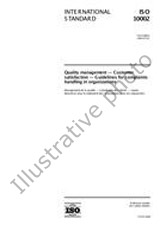We need your consent to use the individual data so that you can see information about your interests, among other things. Click "OK" to give your consent.

ISO/IEC 15944-5-ed.1.0
Information technology - Business operational view - Part 5: Identification and referencing of requirements of jurisdictional domains as sources of external constraints
Translate name
STANDARD published on 20.5.2008
| Language | |
| Format |
|
| Availability | IN STOCK |
| Price | ONREQUEST excl. VAT |
| ON REQUEST |
The information about the standard:
Designation standards: ISO/IEC 15944-5-ed.1.0
Publication date standards: 20.5.2008
SKU: NS-941556
The number of pages: 223
Approximate weight : 700 g (1.54 lbs)
Country: International technical standard
Category: Technical standards ISO
The category - similar standards:
Annotation of standard text ISO/IEC 15944-5-ed.1.0 :
ISO/IEC 15944-5:2008 is directed at being able to identify and reference laws and regulations impacting eBusiness scenarios and scenario components as external constraints. The primary source of such external constraints is jurisdictional domains. ISO/IEC 15944-5:2008 focuses on addressing the simple, i.e. definable, aspects of external constraints for which the source is a jurisdictional domain. A useful characteristic of external constraints is that at the sectoral, national and international levels, etc. focal points and recognized authorities often already exist. The rules and common business practices in many sectoral areas are already known. Use of ISO/IEC 15944-5:2008 (and related standards) will facilitate the transformation of these external constraints (business rules) into specified, registered and reusable scenarios and scenario components. The Business Transaction Model, explained in ISO/IEC 15944-1, has two classes of constraints, namely:
- those which are self-imposed and agreed to as commitments among the parties themselves, i.e. internal constraints; and
- those which are imposed on the parties to a business transaction based on the nature of the good, service and/or rights exchanged, and the nature of the commitment made among the parties (including ability to make commitments, the location, etc.), i.e. external constraints.
We recommend:
Technical standards updating
Do you want to make sure you use only the valid technical standards?
We can offer you a solution which will provide you a monthly overview concerning the updating of standards which you use.
Would you like to know more? Look at this page.



 Cookies
Cookies
